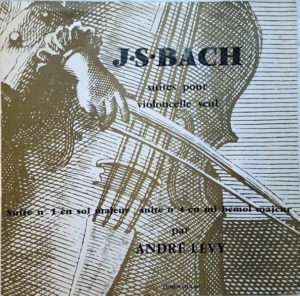

André Lévy. Bach Cello Suites. Reviewed on CD Forgotten records released 2013 Fr 751/2.
Original release 1962 Lumen records in 3 volumes. Re mastered 2017 and 2022
Date of recording 1960.
No information available regards cello used for recording.
Introduction.
As seems to be the norm, there is very little information available about this cellist. He does not even get his own Wikipedia page! From music discography, I learn that he was born in 1894 and died in 1982. He was French and was active during the golden era of French cellists. Perhaps being at the forefront of Fournier, Navarra and of course Tortelier. Some interesting snippets are to be found in this conversation with a former pupil of Lévy, Jean de Spengler.
https://interlude.hk/performance-making-jean-de-spengler-speaks-cello-suites-bach/
Original recordings appear to fetch silly prices in the thousands, hence the expensive re mastered vinyl editions of late.
An unexpected find.
Whilst surfing the internet in my largely fruitless search for information about Lévy, I discovered a surprise! His recording of the sixth Suite Allemende has been used in the soundtrack of a Woody Allen movie (Another Woman 1988 to be exact). Further search along this line reveals that the actor and director has curated 6 volumes of classical music. Amongst the tracks used are movements of Cello Suite recordings and various cello sonatas performed by Casals, Mainardi, Starker and Wenzinger. Mr Allen would appear to be a connoisseur of early cello recordings!
The Recording.
The CD reviewed is yet another of the valuable catalogue from Forgotten records. The quality is very high for a digital remastering from vinyl. There is little intrusion from the vinyl, although one can hear the occasional clunk and bang. Presumably this is from the recording studio on the original recording.
The Music.
The characteristics of this recording are full tone, with plenty of vibrato, legato playing, marked dynamics and a variety of different “voices”. The occasional modest portamento is slipped in. This is not overdone and is really quite appealing although dating. I would liken the effect to be similar to watching an old black and white movie. Acting of the time can be termed “over-acting”. I think it worth considering that the sound equipment on which the original recordings were played was probably quite limited for most people although the 60s was certainly not without a fast growing hi fi market. This being the case, dynamics particularly, may have needed emphasising to be impactful. Like Tortelier later, Lévy phrases very carefully in a conversational way with one phrase responding to another. It comes across in a very musical manner.
Specifics.
The first Prelude starts in a rather unpromising way with a slow pace which picks up after a few bars. This seems to be repeated with the other Preludes. I have noted this tendency with other early recordings. Presumably the opening bars are an introduction of the main theme which is then developed at pace again much as in general conversation. The first gigue is very feisty with crisp rhythm and articulate playing. One of the highlights.
The second Suite initially varies; starting with very sombre Prelude moving to grand and assertive Allemande, and from there on to a lively brisk Courante. The second half is generally sombre with even the gigue having a dark reflective feel.
The rendition of the third Suite Prelude is unusual and not particularly pleasing to the ear. In the extended cross string broken chord passage, this is changed to extensive double stopping. This has the benefit of bringing out the top end tune but loses entirely the sense of momentum in the lower register. The Allemande impresses with its articulation and precise phrasing.
Slow and Sombre.
The fifth Suite Prelude is very slow and sombre which fits its minor key. The sixth Suite Prelude also is very slow and pedantic to start but picks up along the way. The transition from the often-used association of the fifth Suite with Christ’s crucifixion and the sixth with his resurrection is somewhat blurred.
In the last two Suites there are several passages with uncertain intonation and loss of clear articulation. This suggests some technical limitations when compared to the best modern performances. Nevertheless, the gigue is played with enthusiasm and vim!
Across all Suites, the Sarabandes tend to be slow and a little turgid with the intonation being rather exposed by long periods of double stopping. The fifth Sarabande is an exception being quite brisk in parts but highly charged with very sparing vibrato and dramatic dynamics. It sounds very bleak indeed which is a major plus!
Conclusion.
I like this recording for its musical interpretation and sense of sincere performance. However, I would suggest it has limited appeal due to the technical limitations. One for the cognoscenti!
Charles.